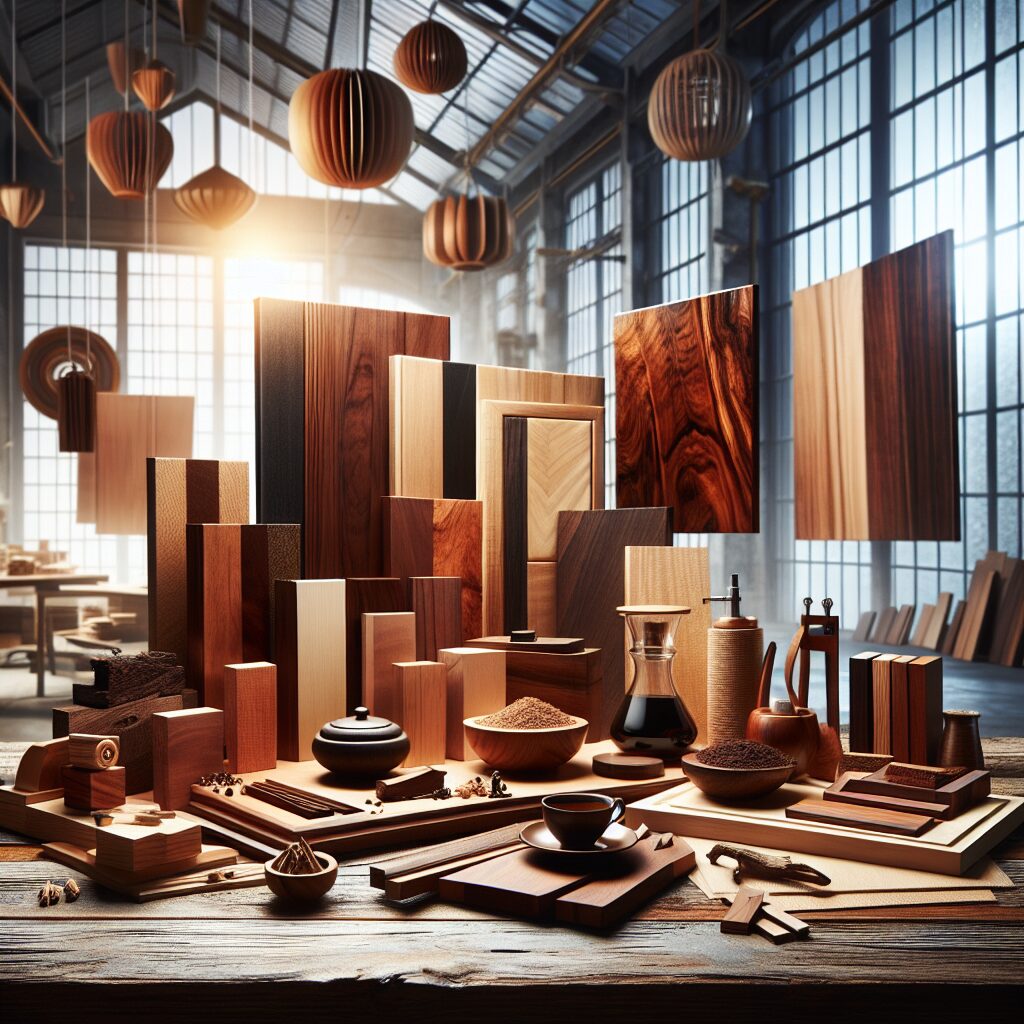When embarking on woodworking projects, the choice of material can significantly influence the outcome. Exotic woods, in particular, offer unique characteristics that can enhance both the aesthetic and functional aspects of your work. Understanding the properties of these woods is crucial for selecting the right type for your specific needs.
Characteristics of Exotic Woods
Exotic woods are known for their distinctive colors, patterns, and textures, which can add a touch of elegance to any project. These woods often come from tropical regions, making them less commonly available than domestic varieties. As a result, they can be more expensive, but their beauty and durability can justify the cost.
One of the primary characteristics of exotic woods is their density. Many exotic species, such as mahogany and teak, are denser than standard woods, which contributes to their strength and durability. This density makes them suitable for high-quality furniture and cabinetry, as they can withstand wear and tear over time. Additionally, their natural oils can offer resistance to moisture and pests, further enhancing their longevity.
Another key feature of exotic woods is their unique grain patterns. For instance, woods like zebrawood and rosewood showcase striking stripes and swirls that can transform simple designs into eye-catching pieces. When planning a project, consider how the grain will affect the overall look and feel. A project using exotic woods can stand out significantly, making it a worthwhile investment for artisans and hobbyists alike.
Popular Types of Exotic Woods
When selecting exotic woods, it’s essential to understand the various types available and their specific properties. Here are some popular choices that you might consider for your next project:
- Teak: Known for its water resistance and rich golden color, teak is often used in outdoor furniture.
- Mahogany: This wood is prized for its deep reddish-brown hue and fine grain, making it ideal for cabinetry and musical instruments.
- Ebony: With its dark, rich color and density, ebony is often used for decorative inlays and high-end furniture.
- Cherry: Although not always classified as exotic, cherry wood has a unique warmth and develops a beautiful patina over time.
Incorporating these woods into your projects can elevate the overall design, providing a touch of luxury. If you are interested in exploring the types of wood available, you will find a diverse range of options to suit your style and needs.
Furthermore, the finishing techniques you choose can greatly influence the final appearance of your project. Exotic woods often require specific wood finishing techniques to enhance their natural beauty and protect them from damage. Understanding these techniques will help you achieve the best results in your woodworking endeavors.
Exotic woods have captivated woodworkers and designers alike, not just for their beauty but also for their unique properties. When embarking on projects that require specific aesthetic or functional qualities, understanding the characteristics of these woods is crucial. This knowledge can help in selecting the right wood for your needs, ensuring that the final product not only looks stunning but also performs well over time.
Physical Properties of Exotic Woods
One of the key aspects to consider when working with exotic woods is their physical properties, which include density, grain pattern, and color. Density plays a significant role in determining the strength and durability of the wood. For instance, woods like mahogany are known for their moderate density, which makes them both strong and workable. On the other hand, species such as lignum vitae have an exceptionally high density, making them incredibly tough and resistant to wear.
Grain patterns can vary widely between different species, contributing to each wood’s unique visual appeal. Some exotic woods, like zebrawood, feature striking striped patterns that can add a dramatic flair to any project. Understanding how these grain patterns behave during cutting and finishing is essential for achieving the desired look in your woodworking endeavors. Additionally, the color of exotic woods can range from rich browns to vibrant reds and yellows, allowing for creative expression in design.
Moreover, the moisture content of exotic woods can affect their stability and workability. Many of these woods originate from tropical climates, where humidity levels are high, which can lead to challenges when they are used in drier environments. Proper acclimatization and storage techniques are vital for ensuring that the wood retains its integrity and does not warp or crack over time. This is particularly important when considering the ecology of wood and how different species adapt to their surroundings.
Finishing and Maintenance of Exotic Woods
Finishing exotic woods requires a keen understanding of their unique properties to achieve the best results. Due to their dense nature, certain finishes may not penetrate as easily as they do with softer woods. Therefore, it’s essential to select appropriate finishing products that enhance the natural beauty without compromising the wood’s integrity. Many woodworkers opt for oils or varnishes that highlight the grain while providing adequate protection against moisture and UV damage.
Maintenance of exotic woods is also an important consideration. Regular cleaning and conditioning can help maintain their luster and prevent damage. For instance, using a soft cloth and a suitable wood conditioner can keep the surface looking fresh and vibrant. Additionally, understanding how to properly care for your project can prolong its life, making it a worthwhile investment. For anyone interested in the therapeutic aspects of woodworking, exploring woodworking therapy can be beneficial, as it emphasizes the importance of quality materials and mindful crafting.
Finally, sourcing exotic woods responsibly is crucial, not only for the environment but also for the longevity of your projects. Many woodworkers are now turning to sustainable practices, such as sourcing reclaimed wood, to reduce their ecological footprint while still enjoying the beauty of exotic species. By understanding where and how your wood is sourced, you can make informed choices that benefit both your projects and the planet.
As we wrap up our exploration of exotic woods, it’s essential to highlight the unique characteristics that make these materials so desirable for various projects. Whether you are crafting furniture, building musical instruments, or creating decorative items, understanding the properties of these woods can significantly influence your choice and the overall outcome of your work. By appreciating their distinct qualities, you can make informed decisions that enhance the beauty and functionality of your creations.
Durability and Stability of Exotic Woods
Exotic woods are often celebrated for their durability, which is a crucial factor when selecting materials for long-lasting projects. Many of these woods possess natural oils and resins that make them resistant to moisture and decay, contributing to their longevity. For instance, woods like teak and mahogany are known for their ability to withstand the elements, making them ideal for outdoor furniture and structures.
In addition to their resistance to the elements, the stability of exotic woods is another significant advantage. Unlike some domestic woods that can warp or twist over time, many exotic varieties maintain their shape and integrity under varying environmental conditions. This stability is particularly important for applications where precision is key, such as in cabinetry or musical instruments.
Moreover, the density of these woods plays a vital role in their performance. Denser woods tend to absorb sound better, making them suitable for high-quality acoustic applications. If you’re interested in enhancing your woodworking skills, exploring wood veneering techniques can further expand your understanding of how to work with these materials effectively.
Visual Appeal and Grain Patterns
One of the most captivating aspects of exotic woods is their stunning visual appeal. Many of these woods feature unique grain patterns and colors that can add a touch of elegance to any project. For example, woods like rosewood and zebrawood are prized for their striking appearances, making them popular choices for decorative items and high-end furniture.
The aesthetic qualities of exotic woods can also be enhanced through various finishing techniques. Applying oils, stains, or varnishes can bring out the natural beauty of the wood, highlighting its grain and color variations. This ability to transform the appearance of a piece can set your work apart, making it not only functional but also a work of art.
Furthermore, the rarity of many exotic woods adds to their allure. The limited availability often makes them more sought after, which can increase their value in the market. If you’re considering using these woods in your projects, it’s essential to balance their beauty with ethical sourcing practices to ensure sustainability.






